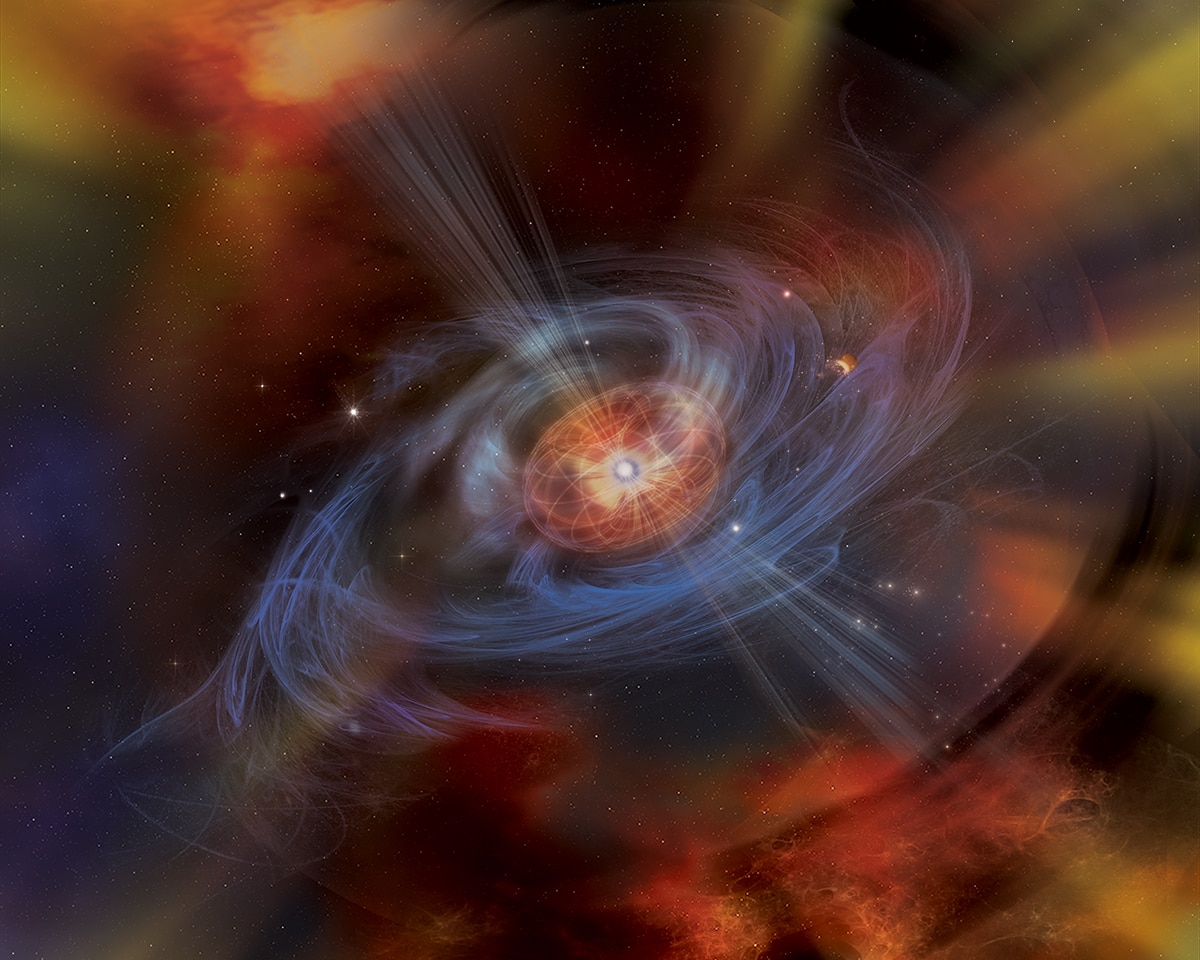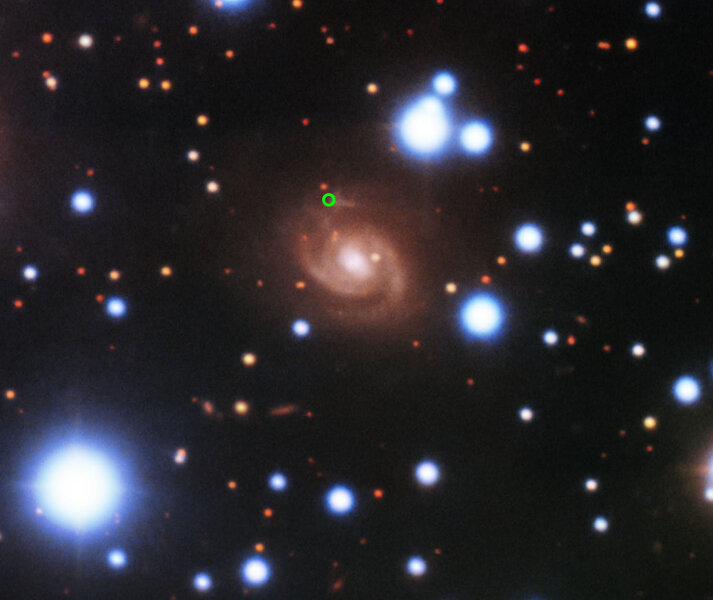Create a free profile to get unlimited access to exclusive videos, sweepstakes, and more!
A Fast Radio Burster is seen to repeat every 16 days... deepening the mystery

There is a stage, in the course of opening up a new field of astronomical discoveries, when you're just trying to collect information as much as you can. Every new object you detect in this newly found category is a treasure, perhaps THE ONE that will finally crack open the mystery of what's going on.
And sometimes — usually pretty often at the start — you find one that makes things even weirder. That's where we are with Fast Radio Bursts, or FRBs.
These are as named: Very quick bursts of radio energy, lasting for mere milliseconds, coming from all over the sky The first was discovered in 2007 (in archived data from 2001), and a few dozen are now known. The problem is that for a long time they were "one and done": Just a flash for that fraction of a second, then nothing. Frustrating.
Then some were found to repeat. That was a huge breakthrough, since it meant they could be localized. It turns out they are very far away, in other galaxies, some billions of light years distant. That's important! That means these are fantastically energetic events, capable of being seen across the observable Universe.
One in particular, first seen less than two years ago, was another biggie: Called FRB 180916.J0158+65 (let's call it FRB 1809 for short), it was localized to the arm of a spiral galaxy 500 million light years away, specifically in a region where stars are being born. That narrows down the potential origin story of this beast even more. Also, it's a repeater — several bursts were seen coming from it — which means it's possible to find out more if you stare at it long enough.
Which brings us to the new bit about FRB 1809, which is pretty peculiar. New observations indicate the bursts are happening in a pattern, repeating every 16.35 days.
No, it's not aliens. But this is a huge clue! Cycles are common in astronomy, and they tend to lead to one of two things: Stuff that spins, and stuff that orbits other stuff. For example, pulsars are rotating neutrons stars — super-dense balls of matter left over when a massive star explodes in a supernova — that emit blips of energy with very tightly constrained periods coming from. Other objects also emit regular periodic cycles of light.
So getting a period for this FRB is good. It helps us figure out what's going on.
Except for the peculiar part. The bursts aren't coming every 16.35 days. That would be too easy. Instead, they come over just a four-day timespan, called the active phase, and just stop. Then, 12 days later, they start up again over that four-day window (completing the 16 day cycle).
… usually. Except, there are some times when no bursts are seen at all during the active phase.
Yeah, OK then. What can make huge blasts of extremely sharp bursts of energy (usually) every four days, then stop for 12, then start up again?
To be honest, the astronomers who discovered this don't know. No one knows (and no, dagnabbit, it's still not aliens!). But that time period is very suggestive of an orbit; most things that spin do so much more rapidly, but orbits can easily be in the couple of weeks range.
The authors propose several potential candidates for FRB 1809, all of which involve the remnants of a dead star: A neutron star or a black hole. A massive star could have a neutron star orbiting it on a 16-day elliptical path, bringing them close together once per orbit. When that happens, the neutron star crashes through the densest part of that stars stellar wind (a wind of subatomic particles like the Sun's solar wind), perhaps creating the bursts.
Or, it could be a powerful pulsar is orbited by a low mass star, and the fierce wind of particles emitted by the pulsar is literally eroding the low-mass star away (these are called black widow pulsars). Or, a black hole might be orbited by a star, and they are interacting magnetically to create the bursts.
The problem is, we just don't know. Worse, it's hard to see how these situations can set up bursts they way they're detected. It's fine to say this looks like a binary system, and one of them is the dense corpse of an exploded star, but how exactly does that make bursts, and how would it space them out over that four-day window?
One thing that does come out of this is that it's unlikely this particular burst is a single object. One possible source of FRBs being considered is a magnetar, a young rapidly rotating neutron star with soul-crushingly strong magnetic fields (even for neutron stars) and other terrifying properties in general. But these have spin periods usually less than 12 seconds, making this FRB unlikely to be from a lone magnetar.
Still… if there's one thing I would bet a lot of money on, it's that there isn't a single kind of source for these bursts. I mean, they may all be neutron stars, say, but they'll be in very different situations, which would account for the differing properties of the bursts. We've seen this before; supernovae come in two broad flavors — massive stars exploding, and low mass white dwarfs exploding, which have entirely different mechanisms but coincidentally generate roughly the same amount of energy. Gamma-ray bursts are another; they come from colliding neutron stars and from black holes being born in massive star explosions.
So I strongly suspect that eventually we'll find out there are different mechanisms that make FRBs. We'll know better as we find more, and more will be found. Now that we know they exist, radio telescopes are being configured to more efficiently look for them. A new study hints very strongly, too, that the bursts seen may only the brightest flashes from objects that also burst much more often, but too faintly to detect. If that's the case, then deeper observations of known bursts may yield a treasure trove of data that can be used to help astronomers understand them.
Until then, though, it's catch as catch can, and if some of them are weird, well, that's the way things will be for a while. But even those help! We may not know exactly what's behind FRB 1809, but the periodicity is a huge clue. If we find another like it, or even one not quite but still kinda like it, that'll help even more.
They're only a mystery for now. One of the most exciting words in science is "… yet."





























